#beaver root
Text
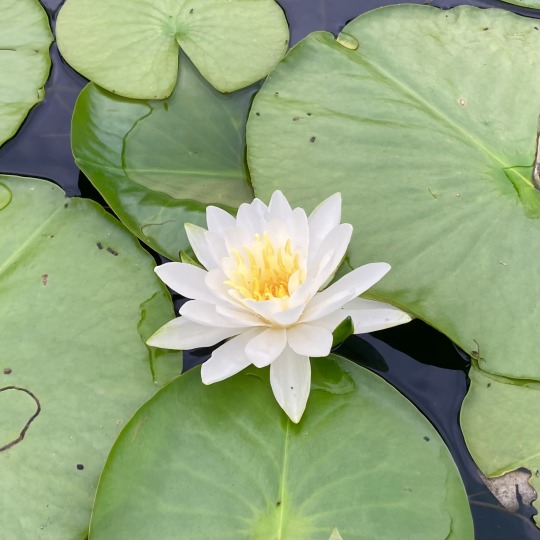

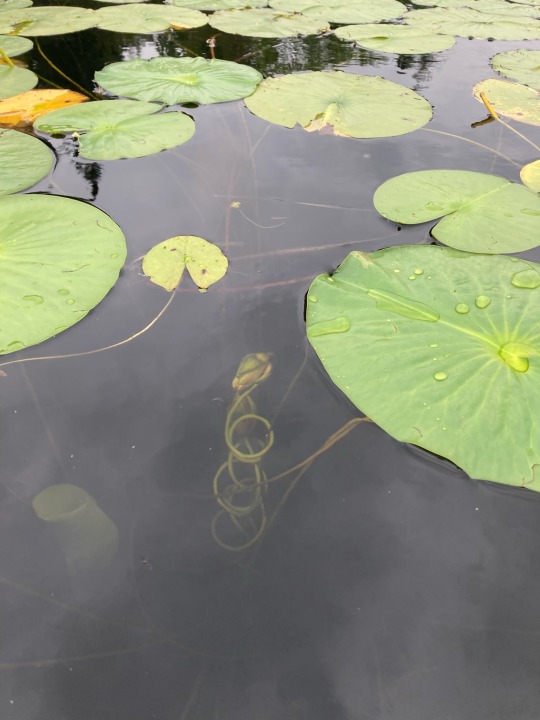



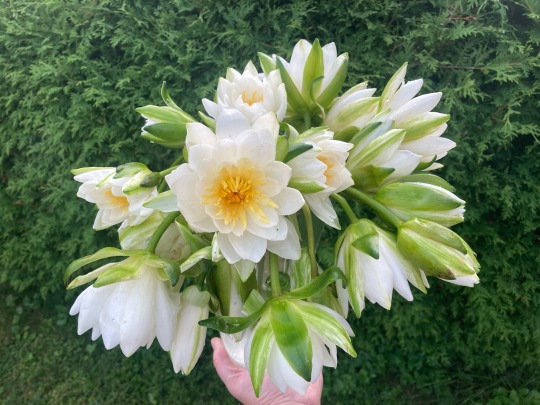
My adventures wild harvesting American white water lilies (nymphaea odorata) this summer for medicine and magic. Nymphaea odorata is native to North America and our local counterpart to blue lotus (aka blue water lily). It is used in Native American medicine to treat coughs, colds, and swelling. Prehistoric Native Americans associated them with purification, the underworld, and the moon.
You can dry and smoke the flowers or make medicinal syrups, tinctures, oils, and ointments with the roots and flowers. Water lilies are not a strong psychoactive. They need to be prepared similarly to lactucarium to make a concentrated extract like the blue lotus resins sold in head shops. That’s not what Bane Folk is about though (plus payment processors ban head shops). I focus on the medicinal uses of poisonous plants with special attention to ones that help with pain, sleep, anxiety, and depression. Water lilies fit that description perfectly.
Water lilies are sedative, hypnotic, anti-inflammatory (especially of mucous membranes and internal tissue), mildly pain relieving, anti anxiety, antibacterial, astringent, and demulcent.
Visit the apothecary to see my offerings of water lily medicines: banefolk.com
#bane folk#fragrant white water lily#beaver root#nymphaea odorata#nymphaea#waterlilies#poisonous plants#edible plants#medicinal plants#psychoactive plants
12 notes
·
View notes
Text
The American White Water Lily is Quite Beautiful
American White
One of our most common flowers in central Florida is the water lily. There are several different types and many of those types have different colored flowers, but one of the prettiest ones is the American white water lily (Nymphaea odorata). It can be found in most of North America and parts of Central America, so it’s not surprising that it also has several other common names…

View On WordPress
#American white water lily#beaver root#Florida water lilies#Florida wildflowers#fragrant water lily#fragrant white water lily#medicinal wildflowers#photography#summer wildflowers#sweet scented water lily#sweet scented white water lily#useful wildflowers#water lilies#water lily photographs#water loving wildflowers#white water lilies#white wildflowers#wildflower photographs#wildflower photography#wildflowers
1 note
·
View note
Text


Two more nature armor sets!
3 notes
·
View notes
Text
I’m going to start watching Oregon St. football for two reasons.
1.) They are doing really good and are a ranked team.
2.) That was the college Adley went to so duh of course I’m going to root for them. 🙄
#adley rutschman#oregon#oregon state beavers#oregon state university#Oregon state#like duh#of course I got to root for Adley’s college#he did play football his first year in college#uh yeah#Oregon state football
2 notes
·
View notes
Text
Oh. That’s a real fourth quarter score. I’m impressed? I think?
#beaver believer#always root for the home team#yes I can talk for hours about women’s college basketball#I love me some college basketball#I think it’s adorable that they let the men play now
0 notes
Text
I randomly found a 500 page French book on OpenLibrary about the etymology of animal names so here are 10 (ish) fun facts:
the French word for poodle, “caniche” looks like it definitely comes from Latin “canis” (dog) but no! It comes from cane / canard (duck) because it was a waterfowl-hunting dog—and its name in English, Swedish, German, Dutch (poodle, pudel, puedel) also reflects this dog’s affinity with water (from pudeln = to splash about). It’s like otters, whose name come from the same root as water...
the canary on the other hand is named after canis / dog, since it comes from the Canary Islands which, according to Pliny the Elder, were named after the huge dogs that lived there at some point. Some historians think these mysterious big dogs were actually seals or big lizards. Then a bird ended up with the name ‘from the dog place’ though it’s unclear if dogs were ever truly involved. (Meanwhile Spain / Hispania comes from the Phoenician i-shepan-im, the place with rabbits.) I like the idea of ancient humans seeing seals or lizards and going “weird dogs”. Like how ancient Greeks saw hyenas and named them “pigs, I guess?”
the fox has a great diversity of names in Europe: fox / Fuchs, zorro, räv, volpe, raposa, lisu, róka, renard... In French it used to be called ‘goupil’, from the same Latin root as the Italian ‘volpe’, but then the mediaeval cycle of poems known as Le Roman de Renart, about an unprincipled fox named Renart, became so popular that renard became the word for fox and goupil disappeared. It’s like if 500 years from now bears in English were called baloos. (The English and German words for fox come from the indo-european root puk- which means tail, like Hungarian ‘farkas’ (wolf) which means tail-having, or squirrel, from the Greek words for shade + tail, there are actually lots of animals that are just “that one with a tail”...)
French has a word for baby rabbit (lapereau) derived from Latin leporellus (little hare) and we used to have a word for adult rabbit (conin) from Latin cuniculus (rabbit)—related to the German Kaninchen, Italian coniglio, Spanish conejo, etc. But ‘conin’ in Old French also meant pussy (there were mediaeval puns about this in the Roman de Renart) and at some point I guess people were like okay, it was funny at first but we’ve run this joke into the ground, and a new and politically correct word appeared for adult rabbit (lapin) based on the pre-existing word for baby rabbit (lapereau).
The english bear is thought to come from the proto-IE root bher-, for brown—I love how Finnish has so many nicknames and euphemisms for “bear” ranging from “honey palm” to “apple of the forest” and English is like... dude’s brown. Same amount of effort with the Swedish and Danish words for fox, räv / ræv, from a root that means reddish-brown. (And the Hungarian word for lion, oroszlán, along with the Turkish ‘aslan’, comes from proto-Turkic arislan / arsilan which comes from arsil which means brown...) And since brown was already taken, ‘beaver’ (+ German, Dutch, Swedish...: Biber, bever, bäver) has been speculated to come from bhe-bhrus-, a doubling of the original root so... brownbrown.
English foal / German Fohlen / French poulain / Italian puledro all come from the proto-IE root pu- which means small (e.g. Latin puer and Greek pais = child)—then the French ‘poulain’ became ‘poulenet’ with the diminutive -et (so, a smallsmall animal) and poulenet became powny in Scots then pony in English, which was then re-imported by French as ‘poney’. Also the Spanish word for donkey, burro, comes from Latin burricus = small horse, and in French Eeyore is named Bourriquet with the -et diminutive ending, so we just keep taking small horses and turning them into smallsmall horses...
The boa (bo(v)a) shares the same etymology as bovine / bœuf / beef, due to a widespread belief that some snakes suckled milk from cows. Pliny the Elder stated this as fact and (not to bully him but) modern research tells us “there is no empirical basis for saying snakes like mammal milk; experiments, indeed, have shown that captive snakes systematically refuse to drink milk”
I was disappointed to learn that antelope comes from Greek anthólops which referred to a mythical creature, because I grew up convinced the origin of the word (antilope in French) was anti-lupus, as in, the gazelle is the generic prey so as a concept it’s the opposite of the wolf, the generic predator. Wolf and anti-wolf. Though it raised the question of why we don’t have antilions (zebra), anticats (mice) and antibears (salmons)
Many European languages have named kites after some sort of flying animal: in English it comes from the word for owl, in Portuguese from the word for parrot, in Italian from eagle, and in French it’s cerf-volant aka flying-deer. There’s an interesting hypothesis for this! Kites came to Europe from China, where they were often shaped like dragons or snakes, and snake is serpent in French and serpe in Old French, so it’s possible that kites were serpe-volants aka flying-snakes. But the ‘p’ and ‘v’ next to one another were a hassle to pronounce so the p got dropped and it became ser-volant, then ‘ser’ which isn’t a word started being mistaken for ‘cerf’ which is pronounced ‘ser’ but means deer...
(We did it again with chauve-souris (bald-mouse = bat), which comes from the Gaulish cawa-sorix aka owl-mouse—which makes more sense as a name for bats! similar to the German Fledermaus, flying-mouse, and Spanish murciélago, blind-mouse. But Gaulish ‘cawa’ was mixed up with Latin ‘calva’ = chauve = bald, so now a French bat is a bald-mouse)
I love etymology, it’s all flying deer and dogs named splash and snakes named cow and ponies named smallsmall and five animals named brown and three named tail—words acquire a veneer of linguistic respectability over the centuries and we forget that fundamentally everyone just says whatever
2K notes
·
View notes
Text
Elements And Their Correspondences
Earth

Direction: North
Time: Midnight
Season: Winter
Color: Green, brown
Zodiac: Taurus, Virgo, Capricorn
Ruling planets: Venus and Saturn
Tarot Cards: Pentacles, Coins
Tools: Pentacle, salt, stones, dirt, crystals, wood, flowers
Cystals: Emerald, Jet, tourmaline, quartz, onyx, azurite, amethyst, jasper, peridot, granite.
Animals: gopher, bear, wolf, ant, horse, stag, deer, dog, cow, bull, bison, snake, worms, moles, voles, grubs
Herbs: Oak, cedar, cypress, honeysuckle, ivy, primrose, sage, grains, patchouli, nuts, magnolia, comfrey, vetivert, moss, lilac, lichen, roots, barley, alfalfa, corn, rice.
Rules: Grounding, strength, healing, success, stability, sturdiness, steadfastness, foundations, empathy, fertility, death, rebirth, wisdom, nature, animals, plants, money, prosperity.
Water

Direction: West
Time: Dusk
Season: Fall
Color: Blue, Indigo, Sliver
Zodiac: Cancer, Scorpio, Pisces
Ruling planets: Moon, Neptune, Pluto
Tarot Cards: Cups
Tools: Ocean, sea glass, cup, bowl, seaweed, hag stones, cauldron
Cystals: Moonstone, pearl, silver, aquamarine, amethyst, blue tourmaline, lapis lazuli, fluorite, coral, blue topaz, beryl, opal, coral
Animals: fish, snake, frog, crab, lobster, eel, shark, dragonfly, seahorse, dolphin, sea otter, seal, whale, alligator, crocodile, beaver, octopus, penguin, salamander, turtle, starfish, koi, coral, barnacle, manta ray, manatee, jellyfish, nautilus, heron, duck, geese, crane, swan, water birds, ammonite, dragons, serpents
Herbs: seaweed, aloe, fern, water lily, lotus, moss, willow, gardenia, apple, catnip, chamomile, cattail, lettuce, kelp, birch, cabbage, coconut, cucumber, comfrey, eucalyptus, gourd, geranium, grape, licorice, lilac, pear, strawberry, tomato
Rules: emotion, intuition, psychic abilities, love, unconscious mind, fertility, self-healing, reflection, lunar energy, deep feelings, curses, death
Fire

Direction: South
Time: Noon
Season: Summer
Color: Red, Orange
Zodiac: Aries, Leo, Sagittarius
Ruling planets: Sun, Mars
Tarot Cards: Wands or Swords (depends on belief system)
Tools: Athame, candles, swords, wands, dagger, lamp, flame
Cystals: Carnelian, red jasper, bloodstone, garnet, ruby, agate, rhodochrosite, gold, pyrite, brass, fire opal, lavastone, tiger's eye
Animals: Lion, snake, coyote, fox, ladybug, bee, shark, scorpion, horse, mantis, tiger
Herbs: Cinnamon, cloves, ginger, allspice, basil, cacti, marigold, chilis, garlic, mustard, nettle, onion, heliotrope, hibiscus, juniper, lime, orange, red pepper, poppies, thistle, coffee, jalapenos, lemon, cumin, saffron, coriander
Rules: Energy, will, destruction, strength, courage, power, passion, lust, sexuality, anger, war, new beginnings, protection, loyalty, transformation, action, movement, achievement, creativity, desire, willpower
Air

Direction: East
Time: Down
Season: Spring
Color: Yellow, gold, white, light blue, pastels
Zodiac: Gemini, Libra, Aquarius
Ruling planets: Mercury, Jupiter, Uranus
Tarot Cards: Wands
Tools: Feather, wand, staff, incense, broom, bell, sword, pen
Cystals: Amber, topaz, citrine, jasper, agate, pumice, alexandrite, amethyst, fluorite, mica, clear quartz
Animals: Birds, flying insects, spiders, bats
Herbs: Bergamot, lavender, marjoram, peppermint, sage, dandelion, bluebell, clover, frankincense, primrose, lemongrass, pine, aspen, yarrow, violets, vervain, myrrh, dill, anise, aspen
Rules: Intelligence, wisdom, knowledge, logic, thought, communication, truth, inspiration, intuition, memory, creativity
Tip jar
#thecupidwitch#witchcraft#witchblr#witchcore#witch community#witches#witch#grimoire#book of shadows#baby witch#beginner witch#witchy#pegan#peganism#chaos witch#magic#magick#wiccablr#wicca
754 notes
·
View notes
Text
Hello Everyone in the Objectified/COTH fandom! I’m creating my own comic about multiple razor packs being at war. It would also be about religious beliefs, homes, and how different packs live. Not all of them can live in forests.
This would give more depth to the forest dwellers we know and love.
So, I’m asking you all to send in your own Razor ocs to be put in the comic! Since I’m not too creative. I need rulers for each pack (4), (4) Stone guardians, civilians for each pack (so about 10) and (2) other main characters!

If you want your oc to be added, please provide a short description of characteristics, the pack wanted to be in, and a reference sheet in a reblog, and not through a message! Thank you!
Here is the pack list and description
Pack Safety: Safety guard hoods and masks that come from a slit on their heads. Most mysterious and deadly pack. They will kill with no hesitation anyone that differs from the “standard archetype” of Pack Safety. A usual defect dealt with is their hoods either not completely covering the face and or not being able to slide on and off. Usually developed by kits “too loved” or too hated, due the hood coming automatically on when under stress. This “disability” is sometimes developed by war veterans too, meaning they have to be executed. Long razor heads with not very much variation in color. Usual beastial type is coyote beastial, if not a coyote beastial, immediately assumed to be a hybrid and is quickly killed with the snap of a neck + the mother’s as well. Live in common pine forest.
Pack Seaside: An aquatic pack that lives on riverbeds and under streams. Have beautiful voices like sirens and fins / gills all around them. Small webs in between talons / fingers. Usually tropical fish and seahorse built tails / fins with alligator limbs other than tail. If furry, usually have Beaver beastial roots
Pack Echo: Usually have draping wings connected to their arms like wyverns, large ears, and night vision. Usually the only razor pack with ears and long tails. They kill or leave kits to die with damaged ears or other injuries, due to the inability to survive in such conditions in the mines and caves they live in. Usually have dragon / bat beastial roots.
Pack Guard: The most loose in control pack, usually with hybrids from other pack types. Thick rubbery glands around face, and usually have magical powers related to thunder (electric razors) only razor type to be able to purr, a signal only used by their pack. Have glowing glands that light up in dark caves/ at night. By far the most artsy and creative pack. Least fearsome pack, though have the most physical strength by far. No definitive beastial type, but bear beastial ancestors were painted on their trees and canvases. Live in common pine forests
#osc#object shows#bfdi#inanimate insanity#osc community#object show#osc comic#objectified osc#objectified comic#coth#cothcomic#call of the heart#comic#razor#razor packs#original character#original art#original comic#oc#ocs#ocs needed#raffle
59 notes
·
View notes
Text
Tony’s Childhood. Part 2.1. Effects: Own Will
Before this part, be sure to read Part 1.
If you're not aware of Tony's strange understanding of the importance of his own wants and needs, check out this post from daydreamsandnightlights.
Here I will try to explain the roots of this behavior.
At age 4 Tony built his first circuit board (IM1)
At age 6 built his first engine (IM1)
Let's think about what it meant that he built all these things at such an early age. Was this his own or his father's will?
Let’s take Morgan for comparison – she is indeed a brilliant kid too, since at the age of 5 she can count up to 3000 (ordinary kids count up to 1000 at the age of 8), knows how much is in a ton, what “disintegrate” means and can easily manipulate her dad, a genius.
Looking at Morgan's behavior, we can assume that she is already capable of building a circuit board under the guidance of her father. But she doesn't. Because her father does not demand this from her. She is a kid. She plays with plush dogs and beavers, sleds on Captain America’s shield, and likes to have bedtime stories read to her before bed. She sneaks into her father’s garage because there are interesting things inside that she can take and play with, not to build something and add it to the list of impressive achievements.

The question is: did Tony want to create things because he liked it, or because his father did it and wanted his son to do the same?


We know that Howard had plans for Tony to "change the world" with Howard's ideas about the future. Apparently, he was preparing Tony for this purpose.
Do small children have a desire to tinker and build things? Some yes. Do they want to or should they play with cubes and constructor sets? Yes. Do they want to or should they work with real motorcycle engines and soldering irons? Hell no. They usually don't have the appropriate motor skills to do this, so they can easily hurt themselves. I'll talk more about this later when I discuss his pain tolerance.
I think it’s impossible to say now whether Tony was interested in engineering from that age (I mean sincere desire, not ability). So we cannot answer that question. But I doubt 4-year-old Tony realized what he was doing when building computer parts. He liked it though. Because those were probably the only times he spent time with his father.

Howard continued to deny his son his will when Tony was sent to boarding school when Tony was 7 years old. There he had a regulated, planned life for 7 years. Then college for another 7. And then became the youngest CEO at 21. None of this sounds like a child’s “I did what I wanted”.

He did not express his will but pleased others. Because this way he received a little love. Or a substitute for love, to be precise. And when, perhaps for the first time, he was taken care of by Yinsen, who saved him, even in such a terrible way, and died for him, he was incredibly grateful. And after that, his attitude towards people changed.

But not the attitude of people towards him, since they continued to want something from him, expecting the same behavior that they were used to seeing from the “rich and famous”.
*Doesn’t want to celebrate his birthday with a bunch of strangers in his house? Wants to spend his last days with the woman he loves? DENIED*



*Needs psychological support from people he trusts? DENIED*






*Wants to save the team from a breakup because he cares and knows what’s coming? DENIED*



Conclusion: Tony didn't belong to himself his whole life. He didn’t use to defend his own, laid deep within, interests. First, his will was moved aside by his father’s. Then Stane’s and the public’s. Fury then came with his Initiative without asking what Tony wanted. Then S.H.I.E.L.D. came to him (not) asking to find Tesseract and save the world. Then the whole team came. Then the government with its Accords, and so on and so forth. None of them bothered to ask, “What do you want, Tony?”. And the only times he insisted on something, were the times when he tried to keep the team together and prevent their death.
#tony stark#iron man#marvel#mcu#the avengers#captain america civil war#avengers age of ultron#iron man 3#pepper potts#avengers endgame#captain america#morgan stark#psychology#iron man 2#howard stark
101 notes
·
View notes
Text
November 2023 witch guide
Full moon: November 27th
New moon: November 13th
Sabbats: None
November Beaver Moon
Known as: Digging(or scratching) moon, Deer rutting moon, Frost moon, Whitefish moon, Mourning Moon, Dark moon, Blotmonath, Fog moon, Mad moon, Moon of storms, Herbistmanoth & Freezing moon
Element: Water
Zodiac: Scorpio & Sagittarius
Nature spirits: Subterranean faeries
Deities: Astarte, Bast, Black Isis, Hecate, Kali, Lakshmi, Mawu, Nicnevin, Osiris & Saraswati
Animals: Crocodile, jackal, scorpion & unicorn
Birds: Goose, owl & sparrow
Trees: Alder, cypress & hazel
Herbs: Betony, blessed thistle, borage, cinquefoil, fennel, grains of paradise & verbena
Flowers: Blooming cacti & chrysanthemum
Scents: Cedar, cherry blossom, hyacinth, lemon, narcissus & peppermint
Stones: Beryl, cat's eye, citrine, yellow sapphire, topaz & turquoise
Colors: Blues, grey, sea green & silver
Energy: Deity communication, cooperation, death, divination, focus, passion, healing, preparation, secrets, sex matters, taking root & transformations.
The Beaver Moon gets its name because it is the time of year when beavers begin to take shelter in their lodges, having laid up sufficient food stores for the long winter ahead. During the fur trade in North America, it was also the season to trap beavers for their thick, winter-ready pelts.
Other celebrations:
• Lunantishees
November 11th
Also known as: The day of the Sidhe
This day celebrates the Lunantishee Faeries & honors the sacred blackthorn tree that they protect. It is said these faeries dance around their host blackthorn tree or bush by the light of the full moon in which they worship. The Lunantishee are closely associated with moonstone as their name of Moon-Sidhe or moon faeries suggest. These faeries are intensely protective guardians who highlight to us the need to protect our homes & our personal energies/ourselves.
In some traditions people would leave offerings like cakes, milk, honey or ale to avert any mischievous behavior from the faeries & if you had a blackthorn tree leave blackthorn blessings upon you.
During this time it is advised to not pick, cut or prune these plants under any circumstances or else misfortune would be placed upon them.
•Night of Hecate
November 16th
Though many choose to honor the Goddess Hecate during this day, there doesn't seem to be any historical evidence suggesting this particular day has any traditional associations or events & likely was mistaken from Hekate's Deipnon which takes place during the dark phase of the moon. However modern practitioners use this day to honor Hekate despite this.
Some celebrate by having a feast filled with wine, mushrooms, bread & more while also leaving some at the threshold of their front door to symbolize the crossroads between indoors and outdoors.
Sources:
Farmersalmanac.com
Llewellyn's Complete Book of Correspondences by Sandra Kines
A Witch's Book of Correspondences by Viktorija Briggs
Llewellyn's 2023 magical almanac: practical magic for everyday living
Wikipedia
#correspondence#witch guide#november 2023#witchblr#wiccablr#paganblr#witch community#witch society#witchcraft#spellwork#hekate#Beaver Moon#traditional witchcraft#grimoire#book of shadows#spellbook#moon magic#witches of tumblr#tumblr witch#witch tumblr#witch tips#beginner witch#baby witch#wheel of the year#sabbat#pagan#wicca#witchcore#witch#GreenWitchcrafts
339 notes
·
View notes
Text
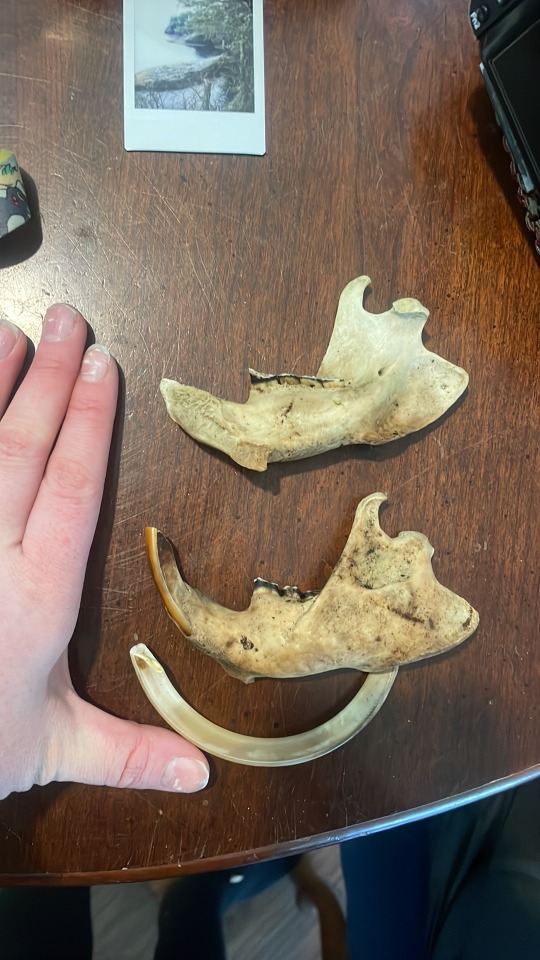
Big fucking beaver jaw, almost a whole inch longer than my biggest. Hopefully I can find the skull next time I go back. Also, if you didn’t know, members of the rodent family continuously grow their teeth. If you pull them out of the bone they have a massive root. Near the far end the tooth is very fragile and paper thin but as it moves forward it hardens.
#I really want a capybara skull now..#vulture culture#it’s been so long since I found a non deer or raccoon skull/bone!!
64 notes
·
View notes
Text
Aesthetic sensibilities are deeply subjective, and hard to acknowledge and analyse clearly. They take root in us from the moment we’re born. They bind us to a particular view of the landscape, something we begin to think of as ‘natural’ or, at least, benign. What we see as children, particularly where we grow up, becomes what we want to continue to see, and what we want our children to see. Nostalgia, and the sense of security that nostalgia brings, binds us to the familiar. We are persuaded, too, by our own absorption in this aesthetic that what we are seeing has been here for ever. We believe the countryside around us, or something very similar to it, has persisted for centuries and the wildlife within it, if not exactly the same, is at least a fair representation of what has been here for centuries. But the ecological processes of the past are hard for the layman – and often even conservation professionals – to grasp.
We are blinded by the immediacy of the present. We look at the landscape and see what is there, not what is missing. And if we do appreciate some sort of ecological loss and change, we tend to go only as far back as our childhood memories, or the memories of our parents or grandparents who tell us ‘there used to be hundreds of lapwings in my day’, ‘skylarks and song thrushes were ten-a-penny’, ‘the fields round here used to be red with poppies and blue with cornflowers’, ‘cod was the poor man’s fish when I was a nipper’. We are blind to the fact that in our grandparents’ grandparents’ day there would have been species-rich wildflower meadows in every parish and coppice woods teeming with butterflies. They would have heard corncrakes and bitterns, seen clouds of turtle doves, thousands of lapwings and hundreds more skylarks. A mere four generations ago they knew rivers swimming with burbot – now extinct in Britain – and eels, and their summer nights were peppered with bats and moths and glow-worms. Their grandparents, in turn, saw nightjars settling on dusty country lanes and even hawking for moths around the street lamps in towns, and spotted flycatchers in every orchard, and meadow pipits everywhere from salt-flats to the crowns of mountains. They saw banks of giant cod and migrating tuna in British waters. They saw our muddy North Sea clear as gin, filtered by oyster beds as large as Wales. And their grandparents, in turn, living at the time of the last beaver in Britain, would have known great bustards, and watched shoals of herring five miles long and three miles broad migrating within sight of the shore, chased by schools of dolphins and sperm whales and the occasional great white shark. We don’t have to look too deeply into the history books, into contemporary accounts, for scenes dramatically different to our own to be normal. Yet we live in denial of these catastrophic losses.
Isabella Tree, Wilding: The Return of Nature to a British Farm
62 notes
·
View notes
Text
Cryptidclaw's WC Prefixes List!
Yall said you were interested in seeing it so here it is!
This is a collection of mostly Flora, Fauna, Rocks, and other such things that can be found in Britain since that’s where the books take place!
I also have other Prefixes that have to do with pelt colors and patterns as well!
Here’s a link to the doc if you dont want to expand a 650 word list on your Tumblr feed lol! the doc is also in my drive linked in my pined post!
below is the actual list! If there are any names you think I should add plz tell me!
EDIT: I will update the doc with new names as I come up with them or have them suggested to me, but I wont update the list on this post! Plz visit my doc for a more updated version!
Animals
Mammal
Badger
Bat
Bear
Beaver
Bison
Boar
Buck
Calf
Cow
Deer
Elk
Fawn
Ferret
Fox
Goat
Hare
Horse
Lamb
Lynx
Marten
Mole
Mouse
Otter
Rabbit
Rat
Seal
Sheep
Shrew
Squirrel
Stoat
Vole
Weasel
Wolf
Wolverine
Amphibians
Frog
Newt
Toad
Reptiles
Scale
Adder
Lizard
Snake
Turtle
Shell
Birds
Bird
Down
Feather
Albatross
Bittern
Buzzard
Chaffinch
Chick
Chicken
Coot
Cormorant
Corvid
Crane
Crow
Curlew
Dove
Duck
Dunlin
Eagle
Egret
Falcon
Finch
Gannet
Goose
Grouse
Gull
Hawk
Hen
Heron
Ibis
Jackdaw
Jay
Kestrel
Kite
Lark
Magpie
Mallard
Merlin
Mockingbird
Murrelet
Nightingale
Osprey
Owl
Partridge
Pelican
Peregrine
Petrel
Pheasant
Pigeon
Plover
Puffin
Quail
Raven
Robin
Rook
Rooster
Ruff
Shrike
Snipe
Sparrow
Starling
Stork
Swallow
Swan
Swift
Tern
Thrasher
Thrush
Vulture
Warbler
Whimbrel
Wren
Freshwater Fish
Fish
Bass
Bream
Carp
Dace
Eel
Lamprey
Loach
Minnow
Perch
Pike
Rudd
Salmon
Sterlet
Tench
Trout
Roach
Saltwater fish and other Sea creatures (would cats be able to find some of these? Probably not, I don't care tho)
Alge
Barnacle
Bass (Saltwater version)
Bream (Saltwater version)
Brill
Clam
Cod
Crab
Dolphin
Eel (Saltwater version)
Flounder
Garfish
Halibut
Kelp
Lobster
Mackerel
Mollusk
Orca
Prawn
Ray
Seal
Shark
Shrimp
Starfish
Sting
Urchin
Whale
Insects and Arachnids
Honey
Insect
Web
Ant
Bee
Beetle
Bug
Butterfly
Caterpillar
Cricket
Damselfly
Dragonfly
Fly
Grasshopper
Grub
Hornet
Maggot
Moth
Spider
Wasp
Worm
Trees
Acorn
Bark
Branch
Forest
Hollow
Log
Root
Stump
Timber
Tree
Twig
Wood
Alder
Apple
Ash
Aspen
Beech
Birch
Cedar
Cherry
Chestnut
Cypress
Elm
Fir
Hawthorn
Hazel
Hemlock
Linden
Maple
Oak
Pear
Poplar
Rowan
Redwood
Spruce
Willow
Yew
Flowers, Shrubs and Other plants
Berry
Blossom
Briar
Field
Flower
Leaf
Meadow
Needle
Petal
Shrub
Stem
Thicket
Thorn
Vine
Anemone
Apricot
Barley
Bellflower
Bluebell
Borage
Bracken
Bramble
Briar
Burnet
Buttercup
Campion
Chamomile
Chanterelle
Chicory
Clover
Cornflower
Daffodil
Daisy
Dandelion
Dogwood
Fallow
Fennel
Fern
Flax
Foxglove
Furze
Garlic
Ginger
Gorse
Grass
Hay
Heather
Holly
Honeysuckle
Hop
Hyacinth
Iris
Ivy
Juniper
Lavender
Lichen
Lilac
Lilly
Mallow
Marigold
Mint
Mistletoe
Moss
Moss
Mushroom
Nettle
Nightshade
Oat
Olive
Orchid
Parsley
Periwinkle
Pine
Poppy
Primrose
Privet
Raspberry
Reed
Reedmace
Rose
Rush
Rye
Saffron
Sage
Sedge
Seed
Snowdrop
Spindle
Strawberry
Tangerine
Tansy
Teasel
Thistle
Thrift
Thyme
Violet
Weed
Wheat
Woodruff
Yarrow
Rocks and earth
Agate
Amber
Amethyst
Arch
Basalt
Bounder
Cave
Chalk
Coal
Copper
Dirt
Dust
Flint
Garnet
Gold
Granite
Hill
Iron
Jagged
Jet
Mountain
Mud
Peak
Pebble
Pinnacle
Pit
Quartz
Ridge
Rock
Rubble
Ruby
Rust(y)
Sand
Sapphire
Sediment
Silt
Silver
Slate
Soil
Spire
Stone
Trench
Zircon
Water Formations
Bay
Cove
Creek
Delta
Lake
Marsh
Ocean
Pool
Puddle
River
Sea
Water
Weather and such
Autumn
Avalanche
Balmy
Blaze
Blizzard
Breeze
Burnt
Chill
Cinder
Cloud
Cold
Dew
Drift
Drizzle
Drought
Dry
Ember
Fall
Fire
Flame
Flood
Fog
Freeze
Frost
Frozen
Gale
Gust
Hail
Ice
Icicle
Lightening
Mist
Muggy
Rain
Scorch
Singe
Sky
Sleet
Sloe
Smoke
Snow
Snowflake
Soot
Sorrel
Spark
Spring
Steam
Storm
Summer
Sun
Thunder
Water
Wave
Wet
Wind
Winter
Celestial??
Comet
Dawn
Dusk
Evening
Midnight
Moon
Morning
Night
Noon
Twilight
Cat Features, Traits, and Misc.
Azure
Beige
Big
Black
Blonde
Blotch(ed)
Blue
Bounce
Bright
Brindle
Broken
Bronze
Brown
Bumble
Burgundy
Call
Carmine
Claw
Cobalt
Cream
Crimson
Cry
Curl(y)
Dapple
Dark
Dot(ted)
Dusky
Ebony
Echo
Fallen
Fleck(ed)
Fluffy
Freckle
Ginger
Golden
Gray
Green
Heavy
Kink
Knot(ted)
Light
Little
Lost
Loud
Marbled
Mew
Milk
Mottle
Mumble
Ochre
Odd
One
Orange
Pale
Patch(ed)
Pounce
Prickle
Ragged
Red
Ripple
Rough
Rugged
Russet
Scarlet
Shade
Shaggy
Sharp
Shimmer
Shining
Small
Smudge
Soft
Song
Speckle
Spike
Splash
Spot(ted)
Streak
Stripe(d)
Strong
Stump(y)
Sweet
Tall
Talon
Tangle
Tatter(ed)
Tawny
Tiny
Tough
Tumble
Twist
Violet
Whisker
Whisper
White
Wild
Wooly
Yellow
#cryptidclaw's warriors au#?#Im tempted to use these in the au#some characters deserve some more fun names hehe#rise of change#warrior cats#warrior cats design#warriors#warriors names#warriors naming#warriors prefixes
552 notes
·
View notes
Text

With Jennifer McLeod at the Hands Across America chain on May 25, 1986. Photo by Maryellen Fleming.
“Taking a stand in Pennsylvania to help the hungry and homeless were Peter Tork of the Monkees, stationed atop Laurel Mountain.” - Pittsburgh Post Gazette, May 27, 1986
“Starting at the Pacific Ocean in Los Angeles, the home base of the organization, the human chain will proceed through the Southwest and Midwest and enter Pennsylvania near Beaver Falls. It will continue through Pittsburgh and leave the state near Waynesboro on its way to Washington, D.C. […] [and to] the final destination of New York City. […] Celebrities on the line in Pennsylvania will include singers Dionne Warwick and Teddy Pendergrass, actors Kevin Bacon and James Darren, and musicians Grover Washington Jr. and Peter Tork.” - Indiana Gazette, May 23, 1986
“All of us [fans] joined the line at 3:00 p.m., and afterwards Peter went to a clearing to sign autographs and pose for pictures for a half hour.
At 3:30 p.m. Peter went back down the mountain to the center of town. A local group called The Bitter Route was playing, and Peter jumped on stage with them to perform ‘Kansas City.’ He then spoke briefly about the worthy cause and signed autographs for nearly two hours until the last person in line had gotten an autograph! […] It was really wonderful that Peter and Jennifer took the time out of their hectic schedules, especially during the very busy pre-tour period, to take part in this kind of an event!" - article by Maryellen Fleming, fanzine, 1980s
“Look at those of us here, right now. We are incredibly fortunate, we’re really very, very lucky. All of us know — I mean, just to take care of the physical side of things — we all know, you know, where we’re going to eat next, and where we’re going to sleep next, and a lot about who our friends are, and a lot about what we’re going to be doing for the next few days, if not weeks, months, and years. And there are people in this world who don’t have any of that. […] [In society] it’s like, ‘I’m taking mine, I’m cutting…, I don’t care what anybody else…’ And it’s like, I don’t know where this all came from, but it seems to be happening everywhere. […] You know, I see… what I think I see is people, they have homes and money, and they think that makes them more human than people who don’t.” - Peter Tork, Q&A at the 1989 Monkees Convention
“Those of us [in the ‘60s] who were truly interested in liberty, fraternity and equality, however, knew we were onto something good and real. What had been called democracy was, and to some extent still is, a pretext for wrapping the will of the greedy and aggressive in a mantle of public acquiescence. Now, the business of wresting power away from those who make a specialty of wielding it will be a long and protracted struggle, with a lot of setbacks along the way. The outlines of the new style of governance are only dimly perceivable, and won’t become clear for a long time to come. In the meantime, our job is to practice the principles of fairness and service to the extent possible. One thing is clear: there is a much higher joy in service than there is in acquisition of wealth. (Remember that it isn’t money that’s the root of all evil, it’s the love of money.) Hanging together in brother — and sisterhood is so happy-making you want to sing right out loud.” - Peter Tork, Ask Peter Tork
20 notes
·
View notes
Text
Animal of the Day!
Mountain Beaver (Aplodontia rufa)
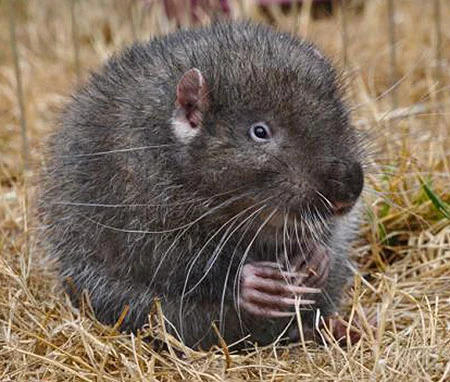
(Photo from Northwest Widlife Online)
Conservation Status- Least Concern
Habitat- Western Canada; Alaska
Size (Weight/Length)- 2 kg; 35 cm
Diet- Leaves; Fruit; Bark; Roots; Ferns
Cool Facts- Despite being called the mountain beaver and looking sort of like a beaver, these rodents are more closely related to squirrels than they are to North American beavers. Mountain beavers do not build dams or chew down trees and their tails are more of a stub. They instead climb trees in search of leaves or wander the ground while munching on toxic ferns when out of their burrow. Their thumbs are semi-opposable, letting the Mountain beaver hold a snack while eating. And boy do they eat, up to 9 hours per day. Young are born as twins or triplets and leave the burrow after only two months. They are one of the longer living rodents of up to 10 years.
Rating- 11/10 (Considered to be a living fossil.)
#animal of the day#animals#mammals#rodents#beavers#squirrels#tuesday#november 14#mountain beaver#biology#science#conservation#the more you know
146 notes
·
View notes
Text
Beginner Hiking Guide Part Two:
Preparations - Knowledge is Power

1. Know what trail you’re taking
You may have decided “I’m going to climb Mount Moosilauke!” -- but there are several different trails up Mount Moosilauke, of varying length and steepness. Are you planning on doing the Beaver Brook Trail or the Gorge Brook Trail? Will you be doing an out-and-back up and down the same trail, or doing a loop where you descend down a different trail to the same trailhead departure point?
Make a plan using the resources from Part One, know the names of the trails if there are interconnecting ones you plan to take, and keep track of blaze colors if you are in an area that uses colored trail blazes. (Blazes are rectangles of paint or other markers on trees and rocks put up by trail maintainers to indicate where the trail is, and which trail you are on)
2. Trailhead location and access
Once you know what trail you’re taking, you’ll want to figure out the location of the trailhead. Some trailheads can be very crowded, so you may want to show up early for parking, or be aware you may need to park a distance away. Also, some backcountry trailheads are on seasonal roads that may be closed during certain times or day or times of year, meaning you may wind up hiking an extra mile or two along a dirt road just to get to the trail.
3. Trail length & elevation gain
How long is the route you’re taking? And what is the elevation gain? (Note: listed elevation for the hike typically refers to the highest point on the hike’s distance from sea level. Elevation gain specifically refers to the gain in elevation from the beginning of the hike to its highest point, since you often aren’t starting at sea level.) Keep in mind that the greater the elevation gain relative to the length of the hike, the steeper the trail will be and the more challenging the hike.
4. How difficult is the trail?
Trail difficulty is hard to gauge precisely, since what is difficult is always going to be relative. Something that might be an easy trail by one person’s judgment may be extremely challenging to another. But there are some factors we can look at for what’s likely to make a trail more or less difficult to hike:
Steepness - determined by elevation gain / length. TrailsNH has a useful “hiking difficulty calculator" to help you get an idea of the overall grade of the trail based on these criteria: https://trailsnh.com/tools/hiking-difficulty.php
Terrain - is the ground flat gravel or full of rocks and tree roots? Does the trail description reference ‘scrambles’, ie, rocky areas where you will need to use your hands as well as your feet to climb up?
Trail Conditions - did it rain heavily yesterday, leaving the trail a slippery, muddy mess? Have there been landslides in the area? Did it snow at elevation?
Looking at the elevation gain and distance can help you determine steepness. Pictures of the trail and reviews may help you get an idea of the terrain. And there may be online hiking communities in your area that report on local trail conditions. (If you hike in the New England area, I recommend https://www.newenglandtrailconditions.com/ ). AllTrails also has a comment section where people sometimes leave useful trail reports with the date, so you can check to see if someone hiked it recently.
5. What is your expected hike duration?
Average human walking pace is about 3 miles an hour. But walking pace and hiking pace can be very different, depending on the trail difficulty -- you may find yourself hiking between 3mph and 1mph. A challenging trail will force you to move slower and more carefully, and you’ll probably want to take breaks -- both to catch your breath, and to enjoy the view!
There are a few different formulae out there for predicting hiking time. “Naismith's Rule” is 19.5 minutes per mile, plus 30 minutes for every 1000 feet of elevation gain, but this really only makes sense if you’re on a trail that has very smooth terrain. “Book time”, which is a bit better suited to rocky terrain like you’ll get on more backcountry trails, states “30 minutes per mile + 30 minutes per 1000 feet of elevation gain.” (Personally, in the White Mountains, I make it 45 minutes per 1000 feet of elevation). TrailsNH has a slightly more involved calculator that factors in overall pace, terrain, and the weight of your pack: https://trailsnh.com/tools/hiking-time-calculator.php . (Note that none of these factor in "snacking time", which is an egregious oversight in my opinion.)
If you’re new to hiking, always err on the side of giving yourself more time than you expect to need, until you get to know your own pace! And be sure to give yourself extra time to enjoy the wilderness without stress.
6. What’s the forecast?
Always look up the weather before you hike! Hikers are far more likely to die of exposure than of bear attacks or whatever else you may think is a threat in backcountry. Pay attention to temperature (extreme heat and extreme cold are both dangerous), humidity (humid days will have you sweating more, so you will need more water), wind speed + wind chill (especially if you’re hiking in exposed areas -- wind is a killer above treeline), and precipitation (you’re at greater risk of hypothermia, even in mild temperatures, if you’re wet). The weather conditions will impact the trail conditions, impact your own physical tolerance, and dictate what you need to bring if you do go hiking, or whether you should even be hiking at all.
There may be different weather concerns depending on where you’re hiking. If you’re hiking in the mountains, you’ll want to make sure you know what the weather is at summit, not just at the base of a trail. It may be 80ºF down in the valley, but below freezing at the top of the mountain. On the other hand, if you’re hiking at low elevation, especially if you’re hiking in a canyon, you’ll want to pay close attention to flash flood warnings.
Useful forecasting tools:
https://forecast.weather.gov/ - NOAA weather forecast, offers detailed hourly weather forecasts
https://www.mountain-forecast.com/ - provides forecasts for mountain summits (including windchill, wind speed, and wind direction)
Knowledge + SAFETY
Before you leave for your hike:
Plan your departure time. Know when sunset is, how long you project your hike to take, and how long it will take to get to the trailhead. Give yourself an ample buffer in case you underestimated your hike duration, and working backwards, plan to leave early enough that you will be done with your hike and back to your car well before the sun goes down so you aren’t stuck blundering through treacherous terrain in the dark (more on this in the next part where we talk about gear!).
Check the weather forecast once again the night before, AND the morning of! Weather can be volatile. If conditions change and become unfavorable, don’t be afraid to reschedule your hike. You cannot outrun mother nature. Numerous people -- including seasoned hikers -- have died in the White Mountains (where I hike) from failing to adequately check the forecasts and getting trapped in deadly weather. There’s no shame in bailing out at the last minute if conditions are just plain bad.
Notify someone reliable in your life of:
Where you are hiking
What trail(s)/route you are taking
How long you expect to take
When to worry and call for help if they haven’t heard from you or can’t get hold of you
Stick to the plan you’ve communicated once you start your hike! If you are injured or lost and don’t have the ability to call for help (dead phone battery, no service, etc.), you will want someone who will recognize that you’re overdue and can call for the authorities to tell them where to look. The sooner someone knows you’re missing, the sooner Search & Rescue teams can be deployed to help you.
<< Previous part: Find Where You Want to Hike
Next part: What to Wear Hiking >>
#Beginner hiking guide#hiking resources#hiking preparation#hiking safety#ongoing series I will be getting to a lot more topics don't worry#lena hikes
58 notes
·
View notes